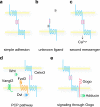Seven-pass transmembrane cadherins: roles and emerging mechanisms in axonal and dendritic patterning
- PMID: 21909747
- PMCID: PMC3229701
- DOI: 10.1007/s12035-011-8201-5
Seven-pass transmembrane cadherins: roles and emerging mechanisms in axonal and dendritic patterning
Abstract
The Flamingo/Celsr seven-transmembrane cadherins represent a conserved subgroup of the cadherin superfamily involved in multiple aspects of development. In the developing nervous system, Fmi/Celsr control axonal blueprint and dendritic morphogenesis from invertebrates to mammals. As expected from their molecular structure, seven-transmembrane cadherins can induce cell-cell homophilic interactions but also intracellular signaling. Fmi/Celsr is known to regulate planar cell polarity (PCP) through interactions with PCP proteins. In the nervous system, Fmi/Celsr can function in collaboration with or independently of other PCP genes. Here, we focus on recent studies which show that seven-transmembrane cadherins use distinct molecular mechanisms to achieve diverse functions in the development of the nervous system.
Figures




Similar articles
-
Protocadherins branch out: Multiple roles in dendrite development.Cell Adh Migr. 2015;9(3):214-26. doi: 10.1080/19336918.2014.1000069. Epub 2015 Apr 14. Cell Adh Migr. 2015. PMID: 25869446 Free PMC article. Review.
-
Potential dual molecular interaction of the Drosophila 7-pass transmembrane cadherin Flamingo in dendritic morphogenesis.J Cell Sci. 2006 Mar 15;119(Pt 6):1118-29. doi: 10.1242/jcs.02832. Epub 2006 Feb 28. J Cell Sci. 2006. PMID: 16507587
-
7TM-Cadherins: developmental roles and future challenges.Adv Exp Med Biol. 2010;706:14-36. doi: 10.1007/978-1-4419-7913-1_2. Adv Exp Med Biol. 2010. PMID: 21618823 Review.
-
Flamingo regulates epiboly and convergence/extension movements through cell cohesive and signalling functions during zebrafish gastrulation.Development. 2009 Feb;136(3):383-92. doi: 10.1242/dev.026542. Epub 2008 Dec 17. Development. 2009. PMID: 19091770 Free PMC article.
-
Developmental expression profiles of Celsr (Flamingo) genes in the mouse.Mech Dev. 2002 Mar;112(1-2):157-60. doi: 10.1016/s0925-4773(01)00623-2. Mech Dev. 2002. PMID: 11850187
Cited by
-
Celsr3 drives development and connectivity of the acoustic startle hindbrain circuit.PLoS Genet. 2024 Oct 21;20(10):e1011415. doi: 10.1371/journal.pgen.1011415. eCollection 2024 Oct. PLoS Genet. 2024. PMID: 39432544 Free PMC article.
-
Protocadherins branch out: Multiple roles in dendrite development.Cell Adh Migr. 2015;9(3):214-26. doi: 10.1080/19336918.2014.1000069. Epub 2015 Apr 14. Cell Adh Migr. 2015. PMID: 25869446 Free PMC article. Review.
-
Planar cell polarity genes, Celsr1-3, in neural development.Neurosci Bull. 2012 Jun;28(3):309-15. doi: 10.1007/s12264-012-1232-8. Neurosci Bull. 2012. PMID: 22622831 Free PMC article. Review.
-
The planar cell polarity protein Vangl2 bidirectionally regulates dendritic branching in cultured hippocampal neurons.Mol Brain. 2014 Nov 12;7:79. doi: 10.1186/s13041-014-0079-5. Mol Brain. 2014. PMID: 25387771 Free PMC article.
-
Nuclear signaling from cadherin adhesion complexes.Curr Top Dev Biol. 2015;112:129-96. doi: 10.1016/bs.ctdb.2014.11.018. Epub 2015 Feb 12. Curr Top Dev Biol. 2015. PMID: 25733140 Free PMC article. Review.
References
-
- Chae J, Kim MJ, Goo JH, Collier S, Gubb D, Charlton J, Adler PN, Park WJ. The Drosophila tissue polarity gene starry night encodes a member of the protocadherin family. Development. 1999;126:5421–5429. - PubMed
MeSH terms
Substances
LinkOut - more resources
Full Text Sources
Research Materials

